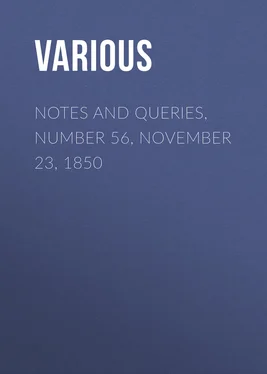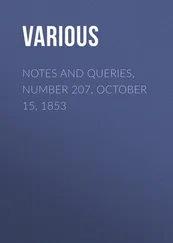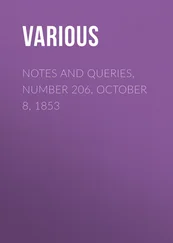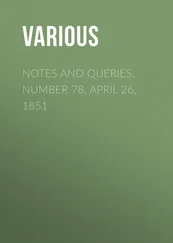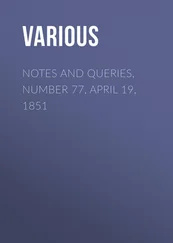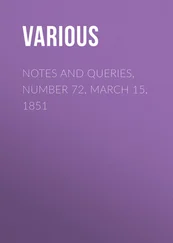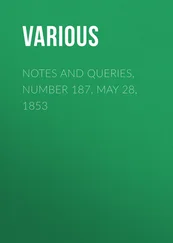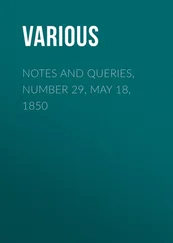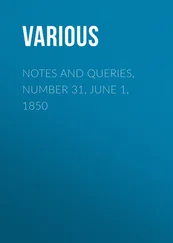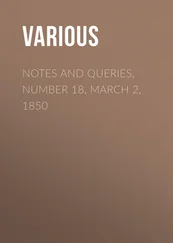Various - Notes and Queries, Number 56, November 23, 1850
Здесь есть возможность читать онлайн «Various - Notes and Queries, Number 56, November 23, 1850» — ознакомительный отрывок электронной книги совершенно бесплатно, а после прочтения отрывка купить полную версию. В некоторых случаях можно слушать аудио, скачать через торрент в формате fb2 и присутствует краткое содержание. Жанр: foreign_antique, periodic, foreign_edu, на английском языке. Описание произведения, (предисловие) а так же отзывы посетителей доступны на портале библиотеки ЛибКат.
- Название:Notes and Queries, Number 56, November 23, 1850
- Автор:
- Жанр:
- Год:неизвестен
- ISBN:нет данных
- Рейтинг книги:4 / 5. Голосов: 1
-
Избранное:Добавить в избранное
- Отзывы:
-
Ваша оценка:
- 80
- 1
- 2
- 3
- 4
- 5
Notes and Queries, Number 56, November 23, 1850: краткое содержание, описание и аннотация
Предлагаем к чтению аннотацию, описание, краткое содержание или предисловие (зависит от того, что написал сам автор книги «Notes and Queries, Number 56, November 23, 1850»). Если вы не нашли необходимую информацию о книге — напишите в комментариях, мы постараемся отыскать её.
Notes and Queries, Number 56, November 23, 1850 — читать онлайн ознакомительный отрывок
Ниже представлен текст книги, разбитый по страницам. Система сохранения места последней прочитанной страницы, позволяет с удобством читать онлайн бесплатно книгу «Notes and Queries, Number 56, November 23, 1850», без необходимости каждый раз заново искать на чём Вы остановились. Поставьте закладку, и сможете в любой момент перейти на страницу, на которой закончили чтение.
Интервал:
Закладка:
Various
Notes and Queries, Number 56, November 23, 1850
NOTES
THE OLDENBURG HORN
The highly interesting collection of pictures at Combe Abbey, the seat of the Earl of Craven, in Warwickshire, was, for the most part, bequeathed by Elizabeth, Queen of Bohemia, the daughter of James I., to her faithful attendant, William, Earl of Craven. The collection has remained, entire and undisturbed, up to the present time. Near the upper end of the long gallery is a picture which doubtless formed a part of the bequest of the Queen of Bohemia, and of which the following is a description:—
Three quarters length: a female figure, standing, with long curling light hair, and a wreath of flowers round the head. She wears a white satin gown, with a yellow edge; gold chain on the stomacher, and pearl buttons down the front. She has a pearl necklace and earrings, with a high plaited chemisette up to the necklace; and four rows of pearls, with a yellow bow, round the sleeve. She holds in her hands a large highly ornamented gold horn. The back-ground consists of mountains. Underneath the picture is this inscription:
"Anno post natum Christum 939. Ottoni comiti Oldenburgico in venatione vehementer sitibundo virgo elegantissima ex monte Osen prodiens cornu argenteum deauratum plenum liquore ut biberet obtulit. Inspecto is liquore adhorruit, ac eundum bibere recusavit. Quo facto, subito Comes a virgine discedens liquorem retro super equum quem mox depilavit effudit, cornuque hic depictum secum Oldenburgum in perpetuam illius memoriam reportavit. Lucretio de Sainct Simon pinxit."
The painting is apparently of the first part of the seventeenth century. The ordinary books of reference do not contain the painter's name.
The same legend as that contained in this inscription, though with fuller details, is given by the brothers Grimm, in their collection of Deutsche Sagen , No. 541. vol. ii. p. 317., from two Oldenburg chronicles. According to this version Otto was Count of Oldenburg in the year 990 or 967. [The chronicles appear to differ as to his date: the inscription of the Combe Abbey picture furnishes a third date.] Being a good hunter, and fond of hunting, he went, on the 20th of July, in this year, attended by his nobles and servants, to hunt in the forest of Bernefeuer. Here he found a deer, and chased it alone from this wood to Mount Osen: but in the pursuit he left his companions and even his dogs behind; and he stood alone, on his white horse, in the middle of the mountain. Being now exhausted by the great heat, he exclaimed: "Would to God that some one had a draught of cold water!" As soon as the count had uttered these words, the mountain opened, and from the chasm there came a beautiful damsel, dressed in fine clothes, with her hair divided over her shoulders, and a wreath of flowers on her head. In her hand she held a precious silver-gilt hunting-horn, filled with some liquid; which she offered to the count, in order that he might drink. The count took the horn, and examined the liquid, but declined to drink it. Whereupon the damsel said: "My dear lord, drink it upon my assurance; for it will do you no harm, but will tend to your good." She added that, if he would drink, he and his family, and all his descendants, and the whole territory of Oldenburg, would prosper: but that, if he refused, there would be discord in the race of the Counts of Oldenburg. The count, as was natural, mistrusted her assurances, and feared to drink out of the horn: however, he retained it in his hand, and swung it behind his back. While it was in this position some of the liquid escaped; and where it fell on the back of the white horse, it took off the hair. When the damsel saw this, she asked him to restore the horn; but the count, with the horn in his hand, hastened away from the mountain, and, on looking back, observed that the damsel had returned into the earth. The count, terrified at the sight, spurred on his horse, and speedily rejoined his attendants: he then recounted to them his adventure, and showed them the silver-gilt horn, which he took with him to Oldenburg. And because this horn was obtained in so wonderful a manner, it was kept as a precious relic by him and all his successors in the reigning house of Oldenburg.
The editors state that richly decorated drinking-horn was formerly preserved, with great care, in the family of Oldenburg; but that, at the present time [1818], it is at Copenhagen.
The same story is related from Hamelmann's Oldenburg Chronicle , by Büsching, in his Volksagen (Leips. 1820), p. 380., who states that there is a representation of the horn in p. 20. of the Chronicle , as well as in the title-page of the first volume of the Wunderhorn .
Those who are accustomed to the interpretation of mythological fictions will at once recognise in this story an explanatory legend, invented for the purpose of giving an interest to a valuable drinking-horn, of ancient work, which belonged to the Counts of Oldenburg. Had the story not started from a basis of real fact, but had been pure fiction, the mountain-spirit would probably have left, not silver gilt , but a gold horn, with the count. Moreover, the manner in which she suffers herself to be outwitted, and her acquiescence in the loss of her horn, without exacting some vengeance from the incredulous count, are not in the spirit of such fictions, nor do they suit the malignant character which the legend itself gives her. If the Oldenburg horn is still preserved at Copenhagen, its date might doubtless be determined by the style of the work.
Mount Osen seems to have been a place which abounded in supernatural beings. Some elves who came from this mountain to take fresh-brewed beer, and left good, though unknown money, to pay for it, are mentioned in another story in the Deutsche Sagen , (No.43. vol. i. p. 55.)
L.[Having had an opportunity of inspecting a copy of Hamelmann's Chronicle , at present belonging to Mr. Quaritch, in which there is a very interesting engraving of the horn in question (which may possibly have been a Charter Horn), we are not disposed to pronounce it older than the latter end of the fifteenth century. If, however, it is still preserved at Copenhagen, some correspondent there will perhaps do us the favour to furnish us with a precise description of it, and with the various legends which are inscribed upon it.—ED.]
GREEK PARTICLES ILLUSTRATED BY THE EASTERN LANGUAGES
The affinity which exists between such of the vernacular languages of India as are offshoots of the Sanscrit, as the Hindostanee, Mahratta, Guzeratee, &c., and the Greek, Latin, German, and English languages, is now well known to European scholars, more especially since the publication of the researches of Vans Kennedy, Professor Bopp of Berlin, &c. Indeed, scarcely a day passes in which the European resident in India may not recognise, in his intercourse with the natives, many familiar words in all those languages, clothed in an oriental dress. I am inclined also to think that new light may be thrown upon some of the impracticable Greek particles by a reference to the languages of the East; and without wishing to be understood as laying down anything dogmatically in the present communication, I hope, through the medium of your valuable publication, to attract attention to this subject, and invite discussion on it. Taking, as an illustration, the 233d line of the first book of the Iliad , where the hero of the poem is violently abusing Agamemnon for depriving him of his prize, the fair maid Briseis, he says,
"Αλλ' εκ τοι ερεω, και επι μεγαν ‛ορκον ‛ομουμαι."
What is the meaning of εκ in the above line? It is commonly construed with ερεω, and translated, "I plainly tell thee—I declare to thee;" εξερεω, "I speak out—proclaim." But may it not be identical with the Sanscrit ek , "one," a word, as most of your readers are doubtless aware, in universal use throughout India, Persia, &c; the rendering literally running thus:
Читать дальшеИнтервал:
Закладка:
Похожие книги на «Notes and Queries, Number 56, November 23, 1850»
Представляем Вашему вниманию похожие книги на «Notes and Queries, Number 56, November 23, 1850» списком для выбора. Мы отобрали схожую по названию и смыслу литературу в надежде предоставить читателям больше вариантов отыскать новые, интересные, ещё непрочитанные произведения.
Обсуждение, отзывы о книге «Notes and Queries, Number 56, November 23, 1850» и просто собственные мнения читателей. Оставьте ваши комментарии, напишите, что Вы думаете о произведении, его смысле или главных героях. Укажите что конкретно понравилось, а что нет, и почему Вы так считаете.
